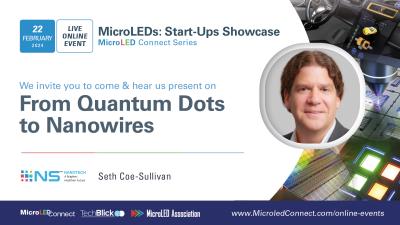NS Nanotech, based in the US, develops nanowire microLED technologies, branded as nanoLED, using MBE deposition. The company targets the microLED display market, and also the LEDs for pathogen-neutralizing far-UV. NS Nanotech's CEO, Seth Coe-Sullivan, will give a talk at the upcoming MicroLED-Connect startup showcase event on February 2024, and was kind enough to send us a short update on the company's technology and status, and his views on the microLED industry and market:
Seth Coe-Sullivan: NS Nanotech is a spin-off from McGill University and the University of Michigan, with offices in Ann Arbor and Montréal near both campuses. We have exclusive licenses to portfolios of patents for breakthroughs in sub-micron-scale vertical nanowire LEDs, and we have published peer-reviewed results showing world-class efficiency for red and green nano-LEDs. And now we are working to demonstrate how this technology can scale to commercially relevant processes and wafer sizes for both main displays and microdisplays.
Our go-to-market strategy involves partnering with larger companies that have the balance sheet to scale quickly, while we remain a technology provider. As we map a clear path to commercialization of our nanowire technology, we have started to fabricate demonstration wafers to make samples available to potential manufacturing partners.
These suppliers to the microLED industry will have to overcome challenges relating to both cost and product capabilities. For microdisplays especially, there is still a significant technical gap in the industry's ability to produce a display that meets the size, brightness, efficiency, and cost requirements of very small displays for augmented reality (AR) applications. And for main displays, the industry needs to be able to use less epitaxy area to deliver the same results in terms of brightness and efficiency. Meeting these challenges will result in the lower costs required to enable mass adoption of microdisplay technologies and to meet the full application potential of main displays.
The microLED market will grow slowly until those barriers of cost and efficiency are fully overcome. Applications requiring lower costs per display size than currently possible are not yet viable. However, we can expect to start seeing more microLED technology appear in niche markets. For premium products with small wearable main displays such as smart watches, it is already happening. But it will take longer to see microdisplays used in lightweight augmented reality glasses that you can wear all day, versus the large virtual reality or mixed reality headsets currently available from Apple, Meta, and others.
New sub-micron-scale microdisplay technologies such as our nanowire LEDs have the potential to disrupt the industry's value chains by delivering orders of magnitude improvements in size, efficiency, cost, and other performance factors critical to next-generation display applications. The industry has been actively discussing microLED commercialization for more than a decide, so the value chain has had time and ample opportunity to react and position itself to incorporate these new technologies. However, there are still alternative technologies such as mini-LEDs, LED backlights, and other accepted technologies that have continued to mature over the past ten years in ways that will deliver many of the promised benefits of microLEDs. So, the technologies in the value chain are not locked in—in fact, we believe the jury is still out on how quickly and to what extent microLEDs might displace the alternatives. However, at NS Nanotech we feel we are well positioned to succeed regardless, given the potential of our nanowire LEDs to fill the epitaxy hole in the existing value chain.
Thank you Seth, looking forward to hearing your lecture in February!
